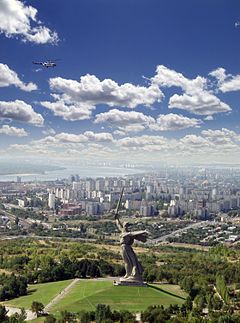The Motherland Calls
| The Motherland Calls | |
|---|---|
| Soviet Union / Commonwealth of Independent States | |

Mamayev Kurgan with the statue
|
|
| For heroes of the Battle of Stalingrad | |
| Unveiled | 15 October 1967 |
| Location |
48°44′32.5″N 44°32′13″E / 48.742361°N 44.53694°E near Mamayev Kurgan, Volgograd |
| Designed by | Yevgeny Vuchetich, Nikolai Nikitin |
The Motherland Calls (Russian: Родина-мать зовёт!, tr. Rodina-mat' zovyot!, literally Homeland-Mother Is Calling) is a statue in Mamayev Kurgan in Volgograd, Russia, commemorating the Battle of Stalingrad. It was designed by sculptor Yevgeny Vuchetich and structural engineer Nikolai Nikitin, and declared the largest statue in the world in 1967. Today, it is the second tallest statue of a woman in the world.
The Motherland Calls is highly complex from an engineering point of view, due to its characteristic posture with a sword raised high in the right hand and the left hand extended in a calling gesture. The technology behind the hollow statue is based on a combination of prestressed concrete with wire ropes structure, a solution which can be found also in another work of Nikitin's, the super-tall Ostankino Tower in Moscow.
The monument was inspired by the Ancient Greek sculpture the Winged Victory of Samothrace, and was modelled on a local woman, Valentina Izotova.
When the memorial was dedicated in 1967 it was the tallest sculpture in the world, measuring 85 metres (279 ft) from the tip of its sword to the top of the plinth. The figure itself measures 52 metres (171 ft), and the sword 33 metres (108 ft). Two hundred steps, symbolizing the 200 days of the Battle of Stalingrad, lead from the bottom of the hill to the monument. The lead sculptor was Yevgeny Vuchetich, and Nikolai Nikitin handled the significant structural engineering challenges of the 7,900 tonnes (7,800 long tons; 8,700 short tons) concrete sculpture. The statue appears on both the current flag and coat of arms of Volgograd Oblast.
...
Wikipedia
